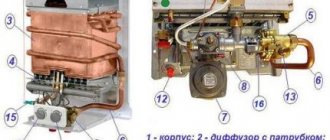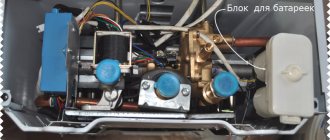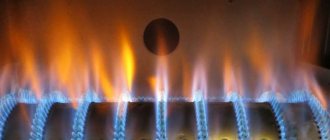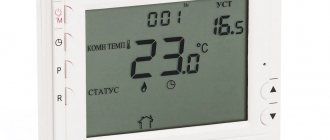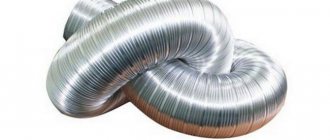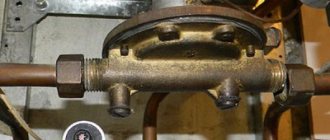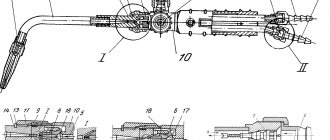Often water heaters are purchased for use at dachas, for work “in the field”. Accordingly, there may be no centralized gas supply in dacha cooperatives and villages. There is a way out - install an electric water heater or choose a gas water heater with the ability to connect to a cylinder. Can a gas water heater run from a gas cylinder? Yes, if the manufacturer has provided such an option. How to connect it and what fuel to use - you will find answers to these questions below.
You can also reconfigure an existing column. To do this, carefully read the instructions in the final part of the article.
Which gas water heater is better to buy?
The choice of heater depends on the number of water points that the boiler will serve and the required volume of hot water, taking into account the needs of the family. But there are a number of technical characteristics that you should also pay attention to when purchasing.
The power of the geyser determines how much hot water and to how many points it can supply:
- Up to 20 kW – one consumer, 11 l/min;
- From 21 to 25 kW – for two points, up to 15 l/min;
- From 26 to 31 kW – for three points, more than 16 l/min.
Combustion chamber type. Inexpensive models use open-type cameras. In them, the combustion of the flame is supported by air coming directly from the room, and combustion products are discharged through the chimney.
When choosing such equipment, you will need to organize fresh ventilation (or simply keep the kitchen window slightly open).
Closed-chamber water heaters use air from outside to support the flame. Soot and smoke are discharged there. You can install such speakers even in closed rooms without windows.
You can learn about other parameters for choosing gas pumps from our article. Now let’s look at the best models of water heating equipment that have recently entered the market.
How to place everything you need
In order to organize enough storage systems in such a kitchen, make the most of every centimeter of space: free space under the windowsill, wall area, etc. On the contrary, keep the decor to a minimum so as not to clutter the room. The design of a kitchen with a stove and a refrigerator, as well as a washing machine, which has to be taken out of a small bathroom in a typical house, requires special skill.
It is possible to place everything you need in a modest area - here special small-sized models of refrigerators and built-in appliances that can be neatly hidden behind kitchen facades will come to the rescue. You don’t have to hide it: for example, washing machines that match the color of the furniture also look nice. Below are examples of kitchen design with a heater and washing machine, as well as an option with a refrigerator.
Design: Line Design Studio
Design: Maya Baklan
If the room is very small, you should abandon the standard layout with a lower and upper line of cabinets - such a set turns out to be too heavy. A good alternative is open shelves or modular facades with transparent or glossy doors. A corner set will also look harmonious in the interior of a small kitchen.
- Kitchen
8 functional examples of kitchen design with an area of 6 square meters. m
The best flow-through geysers with an open chamber
Water heaters with an open combustion chamber are installed in rooms with a chimney and good ventilation.
As a rule, these are the simplest speakers without automatic controls that do not need to be connected to electricity. However, among them there are also more advanced devices.
Our article will help you choose the best geyser: powerful, compact and functional - so that there is always hot water in the tap.
Properly arranging a column in the corner
If the water heater is located in the corner of the kitchen, it is easiest to put it in a corner cabinet. The requirements for it are the same as for other speaker cabinets - without a top, bottom and back wall. Essentially, it is just a door that closes the device.
Also, the corner column can be separated by a special niche, which will visually separate it from the general interior. Do not forget that the wall of the niche facing the device must comply with safety regulations - be covered with non-flammable material.
Which gas water heater is better to buy?
The choice of heater depends on the number of water points that the boiler will serve and the required volume of hot water, taking into account the needs of the family. But there are a number of technical characteristics that you should also pay attention to when purchasing.
The power of the geyser determines how much hot water and to how many points it can supply:
- Up to 20 kW – one consumer, 11 l/min;
- From 21 to 25 kW – for two points, up to 15 l/min;
- From 26 to 31 kW – for three points, more than 16 l/min.
Combustion chamber type. Inexpensive models use open-type cameras. In them, the combustion of the flame is supported by air coming directly from the room, and combustion products are discharged through the chimney.
When choosing such equipment, you will need to organize fresh ventilation (or simply keep the kitchen window slightly open).
Closed-chamber water heaters use air from outside to support the flame. Soot and smoke are discharged there. You can install such speakers even in closed rooms without windows.
Putting it away in the closet
It is advisable to decide on such an option at the stage of ordering a kitchen set. Then a single style will be maintained, the speaker cabinet will not stand out from the rest of the furniture, and the space next to the gas equipment will be used as efficiently as possible.
What you need to consider when making such a cabinet:
- Its dimensions must exceed the dimensions of the column - this is the main safety rule;
- There is no need to make the roof and bottom of the cabinet, as well as the back wall - otherwise ventilation will be impaired, which, again, entails great danger;
- A gas water heater in the closet will take up much more space in the kitchen than without it.
The front door of the box can be made blank - then the device will not be visible at all, and one can only guess about its existence. Or decorative - in the form of a lattice or other artistic elements. The latter option is more preferable not only aesthetically, but also from the point of view of air circulation.
An interesting option from a design point of view is a door made of frosted or slightly tinted glass. Such a “house” for a speaker will look impressive and original. Tinted glass will be especially appropriate if you prefer black appliances or if it is one of the main colors in your kitchen design.
The best flow-through geysers with an open chamber
Water heaters with an open combustion chamber are installed in rooms with a chimney and good ventilation.
As a rule, these are the simplest speakers without automatic controls that do not need to be connected to electricity. However, among them there are also more advanced devices.
For us, residents of megacities, the annual summer shutdown of hot water supply becomes extremely stressful. It is enough to remember how much inconvenience it brings, especially if there are small children in the house. In order to become independent from public utilities and not to deny yourself water treatments, you should take a closer look at water heaters. Let's figure out what types of water heaters there are and how to choose the optimal model for your home or apartment.
Today, there is a wide range of speakers on the market that differ in their operating principles. There are electric and gas models, flow and storage type devices. Today we will talk about gas flow columns. But don’t be afraid, these are not those frightening devices that were previously found in Stalinist guns, but modern devices. They are safe and easy to use, and also have a stylish design.
As practice shows, gas models are in no way inferior to electric water heaters in their performance characteristics, and in a number of ways they are superior to them. For example, they are more economical because... Gas tariffs are significantly lower than electricity prices.
Minimum water pressure
One of the device’s protection schemes ensures that the gas line is automatically shut off (by a shut-off valve) and the dispenser is stopped when the pressure in the pipe drops below what is permissible for this model. This problem is usually faced by owners of apartments on the top floors and owners of country houses that do not have an autonomous water supply system. The indicator in question is extremely important, otherwise the column will either not “start” at all, or will stop periodically.
If in all other respects the product fits perfectly, we can give the following recommendation - additionally install a pump on the pipe (in front of the device) that increases the pressure of the liquid. Some models are capable of “raising” it by 25 - 30%.
Housing material
The body of a gas water heater can be made of:
Despite the fact that enamel coatings are considered obsolete, they continue to be in constant demand among buyers, because... such devices are cheaper. Stainless steel is an almost “eternal” material. It has high strength and is not subject to corrosion. The only caveat is that rust may appear in the welds of the tank over time, but stainless steel devices have a long service life and a stylish appearance.
Hiding between closets
One option to harmoniously fit the speaker into the kitchen interior is to place it between wall cabinets. With this method, it is necessary to take into account that there must be at least three centimeters of free space on the sides of the device to ensure the necessary air circulation.
The walls of adjacent cabinets must be insulated with non-combustible material.
In this case, it is advisable to pay attention to the column itself - it should be a modern, attractive model that will look organically in the current kitchen design. It is advisable that the color of the column be additionally supported by accessories.
Adjusting the flame power
One of the key options of the column is the ability to change the flame power. There are several types of devices:
- with step and smooth adjustment;
- with automatic adjustment.
In the first case, you will have to set the combustion strength manually, thereby achieving the desired water temperature. But you need to understand that it can change during operation of the water heater. For example, if the water in the bathroom is turned on and someone pulls the toilet flush handle, there is a risk of getting burned. The fact is that the flow of water entering the column will decrease and it will heat up more. In addition to this human factor, there may also be surges in cold water pressure independent of anyone, or maybe the column was set up for warm water from the riser, and then really cold water came from the pipeline on the street.
Weak spots
Few people think about this, so it’s worth explaining in more detail. In many of our homes there are still household appliances made during the “Soviet era” (for example, refrigerators, vacuum cleaners), and they work flawlessly. For a modern Manufacturer, this is unprofitable (and this is a fact!), since the longer the equipment operates, the less often people purchase new models. That is why there is a tendency that after a couple of years of operation (or even earlier) repairs are necessary. That's why:
- you need to take the time to talk to professionals (in the same service workshop) about what often fails in such a model. Then it will be possible to buy along with it a couple of the most replaceable parts (in reserve);
- special attention is paid to the number of units made of plastic. It is clear that such structural elements have a service life that is in many ways inferior to “metal” and wear out faster.
Possibility of operation in our conditions. Not all imported geysers are adapted to them. Many models fail during power surges (which is not uncommon for us), are sensitive to water pressure, the gas reducer is configured “wrong”, and the like. You need to immediately find out at what pressure value of the “blue” fuel in the line the device can operate stably.
An analysis of the information provided shows that the choice of the optimal model of a geyser should be purely individual, based on the operating characteristics of the device - the specifics of utilities, the composition of the family, the habits of its members, and so on.
Adjusting the water flow
Many manufacturers produce speakers with the ability to adjust the water pressure. This function allows you to regulate water and temperature comprehensively from maximum temperature and minimum flow to minimum temperature and maximum flow. This is relevant for those who have low water pressure at home, because... in such conditions, the speakers may go out without adjustment or not turn on at all. If the problem is particularly acute, then it is better to take care in advance of purchasing a special booster pump.
Some models of water heaters have gas reducers to maintain constant gas pressure. But we must remember that in our country it is 13 mbar, and this is less than in Western Europe, where it reaches 20 mbar. Remember that the column must be adapted to Russian conditions, because... otherwise it will not gain the required power.
Features of placing a speaker within a small kitchen
The housewife tries to arrange the small kitchen especially carefully, because every piece of space, even the smallest one, is valuable. And the column, as a rule, occupies a significant part of the wall. In addition, in a kitchenette this device looks even more bulky and inappropriate.
First of all, the speaker in such a room should be installed in the smallest size. A mini speaker is easier to disguise and takes up little space. Another important point is that the closer the communications outlets are to the water heater, the less space the communications themselves take up. And then you can use all the already listed methods of decorating the device - hide it in a closet, decorate it to match the tone of the kitchen, or decorate it.
In small rooms, the most advantageous positioning of the speaker is in the corner, where it will not visually hide the space so much and will allow optimal use of the rest of the wall.
Gas ignition
Gas water heaters can have different types of gas ignition:
- piezo ignition;
- automatic spark from batteries or from a hydraulic turbine.
From a practical point of view, the most inconvenient is piezo ignition - you need to turn on the column manually by pressing a button. This may not be so easy, especially if it is located in a hard-to-reach place. In addition, piezo ignition is not economical. After ignition, the igniter continues to burn, consuming gas. As practice shows, gas consumption increases by 1/4.
Spark ignition is convenient. When the water tap is opened, the ignition, gas supply and fan are turned on automatically. After turning off the water, the fan turns off and the gas is shut off. With active use of the water heater, the batteries last for about a year. To monitor their discharge, just pay attention to the corresponding indicator on the speaker body. To activate ignition on devices with a hydraulic turbine, a water pressure of 0.35 to 0.45 ATM is required, while other columns ignite at 0.2 ATM. Thus, with low water pressure, it is better to choose water heaters with automatic ignition from batteries.
Availability of technical/support
This fully applies not only to imported products, but also to domestic ones. If there is no corresponding specialized center in a given locality, then problems will arise not so much with maintenance, but with repairs. As for foreign-made products, such a structure must be authorized. Otherwise, the repair time will be endlessly delayed, and any spare part (and, consequently, the service to restore the functionality of the device) will cost several times more. After all, if the “service” does not have a direct connection with the Manufacturer, then there is also little in the warehouses, and the craftsmen purchase the necessary parts either from resellers or order them in other cities. There is no point in explaining how the price of goods purchased through the “chain” increases.
Control
There are gas water heaters with mechanical and electronic controls on sale. In devices of the first type, control is implemented in the form of a rotary controller or on/off keys. This is the simplest, most reliable and inexpensive option. For additional convenience, the speakers are equipped with operating mode indicators and a temperature scale.
Electronically controlled speakers are easier to use. Just a couple of clicks are enough and the device is configured and ready to go. For additional convenience, the water heaters are equipped with an LCD display, which displays all control processes and current settings. Of course, such columns are more expensive than mechanically controlled water heaters.
Corner kitchen solution
Small kitchens, in which the furniture is located in a remote corner of the room, also have several design solutions for installing a gas water heater.
As in the case of a Khrushchev apartment, this can be a cabinet, which, although it will steal space for storing items, can still hide the column and communications connected to it.
Another interesting option involves a well-chosen color scheme for the headset and speakers.
There is also the possibility of additional decoration of the column using a variety of stickers or painting it in a suitable color. In this case, it can be installed anywhere, for example in a corner, outside of cabinets. The main thing is that this does not happen over a gas stove.
Safety
Despite the modernity of the device, the geyser is considered a high-risk device. To make it as safe as possible, water heaters are supplemented with all kinds of devices:
- Combustion and ionization sensors. They instantly shut off the gas supply when the flame goes out.
- Overheat sensor. It prevents the heat exchanger from overheating and eliminates the risk of water burns.
- Traction sensor. It prevents the device from being turned on if there is insufficient traction.
- Flow sensor. The device turns on only when the tap is open, otherwise it turns off automatically.
- Cold and hot water temperature sensors for adjusting combustion strength.
- Protection against insufficient water pressure. It does not allow the column to turn on if the water pressure is insufficient for safe operation.
- Relief safety valve. It eliminates the risk of rupture of the heat exchanger in case of increased water pressure.
Hide or decorate?
Before deciding what to do with a geyser, you need to decide what financial capabilities you are based on and to what extent you visually dislike this device. If you are ready to allocate a small amount for a more harmonious appearance of the speaker, and it does not cause much outrage, you can simply decorate it. If the rejection is strong and you want to hide it completely, you will have to spend a more serious amount.
Let's sum it up
Before buying a geyser, it is better to make a list of points that will make it easier to choose the right model:
- dimensions and installation method (floor-mounted, wall-mounted);
- regularity of use of the water dispenser (only during the water outage season or year-round) and the number of water intake points;
- water heater power and performance;
- device price.
The last factor plays an important role, because The price range for gas water heaters is quite large. So, having spent:
- from 4900 to 7000 rubles you can buy the simplest gas water heaters with mechanical control. Their power reaches 20 kW and their productivity is 10 liters/min, which is quite enough for use in the bathroom.
- from 7,000 to 10,000 rubles you will receive a reliable gas water heater with electronic control, gas control, power up to 20 kW and productivity up to 10 liters/min.
- from 10,000 to 15,000 rubles you can buy reliable and practical geysers with mechanical and electronic controls, with gas control. This range also includes devices with a power of up to 24 kW and a capacity of up to 14 liters/min, which allows you to power two water intake points.
- from 15,000 rubles or more you will receive reliable gas water heaters, created taking into account all safety requirements. They have a stylish appearance and provide a stable supply of hot water even at low water pressure. The ability to set the temperature and an informative display allow you to configure the device with just a few hand movements. Such water heaters have automatic ignition, which guarantees special convenience during operation. The high power and performance of the speakers allow you to connect several water intake points to them.
Device performance
Even columns of the same power consumption can provide heating of different amounts of liquid (in “l”) by NN number of degrees per unit of time (for columns this is 1 minute). This is due to the design features and characteristics of the components. Productivity is indicated by the symbol “∆t 0С”.
This parameter is related to power, and this should be taken into account. Here are some approximate data showing what consumption is optimal for what purposes:
- mixer in the kitchen - approximately 3.5 l/min;
- shower - about 8.
If you are primarily interested in the performance of the device, then you need to focus on it. In this case, the required power is calculated as follows:
V x (t1 – t2) /14.3
Example
It is necessary to simultaneously provide water (hot) to 2 points. Consumption in the kitchen – 3, in the shower – 7, total (V) – 10 (l/min). At the column inlet the water temperature is 5 0C (t1), at the outlet – 50 0C (t2).
We get: 10 x 45: 14.3 = 31.5 (kW). And if you increase this figure by 1/3, you get about 40. Therefore, you need to look for a speaker with approximately the same power.
But in practice, we will never have 2 parsing points “working” at the same time, and for a long time. Therefore, the product can be used with less power. Practice shows that during periodic operation with 2 taps, it is enough for it to be at least 20 - 24 kW.
Major breakdowns
Here are several reasons why a gas water heater does not heat water:
- Dirty heat exchanger. Regardless of the warranty, this happens with all heating devices. The pipes from the inside become clogged with smoke and lime deposits, as a result the gas water heater burns but does not heat;
- Damage to the gas valve in the burner. If this happens, the flame power is not enough to heat the water;
- Manufacturing defects. Most often, the problem is in the main element of the column - the heat exchanger. And this is one of the most common reasons why a gas water heater does not heat;
- The pressure in the gas pipe is reduced. Problems in the gas supply system and are not related to the operation of the device;
- The ignition is broken. It happens that the column does not turn on if the ignition is broken or the battery is dead.
These are not the only options why a gas water heater does not heat water well. Each is worth considering separately.
Dirty chimney
One of the main reasons why a gas water heater does not heat water well is a clogged chimney. If the pipe is clogged with debris, there is not enough draft for normal operation of the device.
This defect can be easily eliminated; just remove the chimney and clean it from the inside. If everything is done correctly, cravings will appear.
How to check:
- Light a match;
- Bring it to the well;
- Look at the light.
The flame has deviated - there is draft, it burns evenly - you need to clean it again. If, after cleaning the chimney, the water heater still does not heat the water well, the reason must be sought elsewhere.
Faulty ignition system
If the water heater does not ignite at all, there is an ignition problem. This only happens with automatic, battery-powered appliances. Despite the fact that, according to advertising, batteries last a whole year, in reality they run out much earlier.
To understand why the speaker does not heat up after replacing the battery, you need to carefully look at the contacts. If they are oxidized, they need to be cleaned and try to light the device again. Monitor the ignition keys and periodically check their operation.
Weak pressure
Another reason why the geyser does not heat is the false alarm of the safety sensors. If the water pressure is too low, the system turns off the device. Options:
- Contact your utility service to determine the cause of the problem. It is quite possible that the problem is due to faulty pipes;
- Clean the filters;
- Clean water heating elements from scale, soot and soot;
- Check the condition of the membrane.
It happens that with low pressure the device heats the water too much. This often happens with older models. Such speakers do not have a protection system; they continue to burn even if there is no water. It would be safer to replace the device with a more modern one.
Broken water supply system
To figure out why the Mora gas water heater does not heat well, you need to check whether everything is configured correctly. The fire goes out if the supply of cold and hot water is turned on at the same time. This violates the operating rules of the water heater. To eliminate the defect, just turn off the cold tap or reduce the pressure.
Worn seal diaphragm
If the gas water heater no longer heats the water, the problem may be an outdated valve membrane. This part is constantly subject to load, as a result it gradually wears out. As a result, the combustion sensor stops working and the column does not turn on.
It is impossible to prevent breakage; rubber gradually loses its elasticity. It’s easy to check the operation of the membrane - turn on the hot water to maximum. If the device goes out, then it’s time to change the part. Experts advise doing this every 5 years.
Attenuation during operation
If the water does not heat up because the Vector gas water heater goes out immediately or after a while after being turned on, this means the following:
- The contacts between the thermocouple and the magnetic valve are broken. Sometimes the reason why a geyser does not heat water is due to short circuits. This happens due to broken insulation. As a result, the device lights up and goes out in a chaotic manner. You can fix this problem by replacing the wires.
- The automatic control parts of the device have failed. You can understand this by observing the operation of the heater. If the column works normally for about 10 minutes, then goes out, and then lights up again, then the combustion sensor needs to be repaired.
Important! To repair electronics, it is better to call a specialist.
Scale
Most often this problem occurs when water is too hard. Salts settle on the inside of the water heater pipes, resulting in a decrease in pressure and a drop in temperature. If the gas water heater begins to heat the water poorly, it is probably clogged due to scale.
You can clean the heat exchanger yourself using:
- Store-bought descaler;
- Vinegar;
- Lemon juice.
To access the heat exchanger, remove the housing and shut off the incoming water supply.
Further actions:
- Disconnect the water pipe from the heat exchanger.
- Drain off any remaining liquid.
- Attach a rubber hose to the coil, lift it higher and pour in descaling liquid.
- After 2.5 hours, reconnect the heat exchanger to the water pipe and turn on the tap.
If everything is done correctly, dirty water with flakes and scale residues will flow out. Next, all that remains is to clean the heat exchanger again and return the housing to its place.
Water supply blockage
If the water in the gas water heater does not heat up, the reason may be a simple blockage in the water supply.
To clean the pipes, you need to start the reverse flow:
- Set the third position on the faucet;
- Open all taps fully;
- Open the damper;
- Place a container for liquid.
In some cases, the problem is a clogged filter on the water unit. If the above steps do not help, contact your utility service. You may have to replace too old pipes with new ones.
If the water heater works but does not heat the water in the bathroom, it makes sense to check the watering can, shower hose and mixer. If necessary, unclog them. After the procedure, turn the tap on full and check if the water heats up.
Important! Sometimes the pressure drops due to an accident; the utility service must inform you when the water supply will be restored.
Column leak
Sometimes a geyser does not heat water well if there is a leak. This can be seen with the naked eye when a dark oily liquid flows through the pipes. Why is this happening:
- The gaskets are worn out;
- Corrosion in the heat exchanger.
In the first case, everything is simple - just replace the gaskets with new ones. It is best to choose a sealant made of silicone; this material has a longer service life.
But if the reason why the device does not heat well is corrosion of the copper tube of the heat exchanger, you will have to solder the hole. It is impossible to do this yourself; you will have to call a specialist. Despite the complexity of the work, soldering will cost less than buying a new part.
Humming during operation
If the geyser is humming, this is due to the same reasons as with poor water heating:
- The craving is gone;
- Scale in the coil;
- Damage to the gas valve.
It is enough to eliminate one of the listed problems so that the device starts supplying hot water and stops making noise.
Lack of maintenance
Depending on the type of model and brand of manufacturer, each device has its own characteristics. To prevent the gas water heater from suddenly stopping heating water, you need to carry out maintenance on time. An annual inspection of the equipment will extend the life of your water heater and help identify potential problems.
What else could happen
Sometimes the opposite happens and the gas water heater greatly heats the water, bringing it almost to a boil.
This is due to:
- Clogged heat exchanger pipes;
- Low pressure.
In this case, even with a weak fire, the water heats up strongly to +50 degrees and above.
How to understand that repairs are urgently needed:
- The pressure of hot water is much weaker than cold;
- The gas water heater is noisy.
Repairs are needed immediately. Under no circumstances should you try to repair the device yourself. If the temperature in the coil rises so much that boiling water flows through the pipes, an explosion will occur. The only thing you can do yourself before the technician arrives is to rinse the heat exchanger tubes.
Features of speaker maintenance and repair
Malfunctions in the operation of water heating equipment are quite often associated with blockages, difficulties in supplying water and gas. To easily diagnose problems, it is advisable to familiarize yourself with the design of the water heating device and the principle of its operation.
If you plan to repair a geyser yourself, it is important to understand its structure and study the operating instructions
Externally, the speakers may look different, but the principle of their operation remains unchanged.
All equipment that provides instantaneous heating of water has similar components and parts:
- The housing protecting the device can be made of steel, cast iron, and various alloys. It houses a control panel, and in advanced models there is also a display for displaying information. If the column does not heat the water well, an error code will appear on the screen.
- Main burner, igniter.
- Heat exchanger made in the form of tubes. Water moves through it and is heated here. Often this unit is the cause of gas heater malfunction.
- The combustion chamber . It can be open or closed. Here the fuel energy is converted into heat.
- Water knot . After opening the tap, the flow of water passing through this unit activates the membrane. It acts on the rod, which, in turn, opens the valve and allows gas to flow into the burner.
- Gas valve . He is responsible for supplying gas to the system. If there is a problem with its operation, the column may not work correctly.
- Chimney is an opening for the exit of fuel combustion products.
The operating principle of a gas water heater is quite simple. When the user opens the hot water tap, cold water and gas are supplied to the device, and the burner is lit at the same time.
Cold water passes through the heat exchanger tubes, gradually heating up. Combustion products are redirected to the street through a chimney or a special opening.
We talked in more detail about the principle of operation of the water heater in the article: The principle of operation of a gas water heater: features of the design and operation of a gas water heater
The main unit of the geyser is the heat exchanger. To prevent scale formation in it, you can install a filter at the inlet
To quickly heat water, it is important to maintain the functionality of all components of the dispenser and carry out periodic maintenance of gas equipment.
The nuances of descaling a radiator
During operation of a gas water heater, scale may form inside the radiator tubes - when hard water is heated, salts and metals are deposited on the inner walls of the heat exchanger. As a result, the lumen narrows, and deposits attached to the walls do not allow the heat exchanger to warm up well.
As a result, cold water is supplied perfectly, the gas burner works normally. However, at the exit the user receives slightly heated water. You can fix this defect yourself.
To clean a water heater, you need to thoroughly rinse the tubes. Professionals use a special radiator cleaner. A solution of vinegar (citric acid) is suitable for the home handyman.
You can descale the heat exchanger at home with a solution of citric acid or vinegar. But first you have to remove the radiator from the speaker body
To disassemble and clean the gas water heater, you must have the following tools and materials:
- a set of keys;
- silicone gaskets;
- tube with a funnel for pouring the cleaning mixture.
Before starting work, it is necessary to close the cold water and gas supply taps. Open the hot water tap to drain liquid from the system. Then you need to remove the fittings and unscrew the housing.
After this, you need to remove the tube adjacent to the heat exchanger and drain the remaining water, which may still be about half a liter.
To carry out cleaning, you need to pour a heated solution of citric acid (vinegar) into the heat exchanger and leave for a couple of hours. At the end of the period, connect the coil to the water supply and rinse thoroughly. If desired, repeat the procedure.
Features of eliminating leaks in the column
When water leaks are noticed while using a gas heater, the cause of the malfunction may be the following:
- incorrect connection of the device to the water supply;
- failure of seals located at joints;
- the appearance of a fistula in the heat exchanger tube.
In the first two options, repairs will not be difficult since it is enough to correctly connect the device or replace the gaskets.
Professionals recommend choosing silicone seals, which ensure a tight connection and last a long time. When planning work, it is worth stocking up on gaskets for all connections in order to replace them simultaneously in the entire column and not encounter a similar problem in another place in a short time.
If the holes in the heat exchanger are small, then you can solder them yourself, but the best solution would be to replace the unit
You can try to solder the leaking section of the heat exchanger tube. This will provide a temporary effect and prolong the operation of the gas heater. However, after a fairly short period of time, the fistula may appear in another place, so it is advisable that instead of soldering, professionals recommend a complete replacement of the heat exchanger.
Why doesn't the speaker heat up?
You need to understand the principle of operation of the device to understand this. Working parts are hidden behind the metal body. The water unit consists of a membrane and a gas valve. When water begins to enter the system and the pressure rises, the valve opens and gas is supplied to the burner.
An important element of the system is the heat exchanger. Water circulates through its tubes, which is heated by the burner. Hot liquid is supplied to the mixer.
Modern models have special sensors and functions that protect the device from damage. Based on the type of ignition, devices can be divided into several types:
- Devices with piezo ignition - mechanical ignition of the burner.
- Electrical system - ignition using batteries.
- Hydraulic - working with a turbine.
Diagnostics and troubleshooting
Diagnostics of a gas heater includes its thorough examination to identify possible causes that led to a decrease in the efficiency of the device, and their subsequent elimination.
Clogged chimney
The first reason why the water is barely warm or does not heat up at all is a blockage in the ventilation of the gas water heater.
Important! A chimney clogged with smoke, soot or other debris cannot provide the draft necessary for operation, so the water heater's protective systems stop the gas supply.
You can determine such a malfunction by placing a lit match near the ventilation hole. If the flame burns evenly, without hesitation, this means there is no draft. This version is also supported by falling flakes of black soot. Another sign is that the fire burns with a yellow flame. This situation arises in the absence of regular cleaning of the column.
You can fix this problem yourself; to do this, you need to clean the ventilation shaft from soot, debris and other foreign objects. To check the chimney for draft after work, you can take a burning candle or lighter and bring it to the ventilation. If the flame deviates significantly, it means there is draft.
Heat exchanger wear
With prolonged operation, the heat exchanger wears out and a leak may occur. This is typical for parts of poor quality, in which the element is not made of pure copper, but with impurities. At the sites of impurities, the surface oxidizes and fistulas appear.
Advice! If the cracks or holes are small, you can try to solder them, but the best solution would be to completely replace the heat exchanger.
Problem with the ignition system
If the flame does not light in a Bosch or Neva dispenser with automatic ignition and the water does not heat up, you need to check the condition of the batteries. They tend to regularly discharge and fail, and sometimes oxidize. In some cases, defective batteries may be found. To check the ignition system, you need to change the batteries and, if the problem persists, diagnose the button that supplies the spark to ignite the gas .
We recommend reading: Heating radiators in the floor under the windows: how to make it yourself
Insufficient pressure
Sometimes a geyser may not perform its functions due to the fact that the protection system against turning on without water is triggered. This can happen if there is poor pressure in centralized water supply pipes. To verify this reason, you need to open the cold water tap valve and look at the stream. If it really flows weakly, then there are problems in the water supply.
To correct the situation, you must first call the utility company and find out if they are carrying out maintenance or repair work. If the answer is negative, you should clean the filters at the entrance to the gas water heater and/or the water supply system in the house from dirt and debris.
Advice! To clear clogged pipes in an apartment building, you must submit a request to the utility service.
In addition to these actions, you need to clean the gas water heater from soot and dust, and also check the integrity and proper functioning of the membrane, and if necessary, install a new part.
Irregularities in water supply
Such a breakdown occurs rarely and indicates incorrect settings of the water heater. If the flame lights up but goes out immediately or after a short time, this indicates an imbalance in the hot and cold water supply system.
Advice! On many forums you can read the opinion of experts that it is not recommended to mix cold water with hot water while the water heater is operating, since this does not comply with the rules for operating the device and also leads to extinction of the flame.
To eliminate this problem, you need to reduce the flow of cold water.
Malfunction in the separating membrane
If the membrane installed in the check valve has worked for a long time, it may cause a malfunction of the gas water heater. Due to regular loads and constant work, the unit tends to deform. As a result, the burner ignition sensor becomes less sensitive, gas does not flow to the burner, and the flame goes out. It is impossible to prevent such damage; even the highest quality membranes gradually lose their elasticity during operation . Speaker manufacturers, as well as service specialists, advise replacing this part every five to seven years of continuous operation.
You can make sure that the cause of the breakdown is the membrane by turning on the water flow to maximum. If the gas burner goes out, the diagnosis can be considered confirmed. To fix the problem, you will need to replace the part.
The flame goes out
If the gas water heater ignites properly, but goes out during operation, this may indicate a breakdown of the bimetallic sensor. It is designed to measure temperature to protect the water heater from overheating. Such a malfunction can manifest itself in different ways.
- In some cases, the device turns on, heats the water, but soon goes out, and it is impossible to restart it. After about ten minutes, the column turns on again, works and goes out again after a short time. This is due to the increased sensitivity of the bimetallic sensor.
- In other cases, the column lights up and goes out after an arbitrary time without any visible dependence. It is impossible to guess how long it will work properly. This type of failure is usually caused by damaged wiring. Due to broken insulation, short circuits to the housing occur, and the fuse also trips.
Important! Malfunctions of the bimetallic sensor cannot be eliminated independently. In this situation, you need to seek help from professionals.
In some cases, the device overheats in the summer due to extreme heat and stuffiness in the bathroom (or other room). This is not a defect, but to prevent blackouts, you can move the column to another room or seek advice from professionals.
Scale
Another reason why a Beretta, Junkers, Vektor or other manufacturer’s water heater does not heat water or heats it very poorly is scale on the heat exchanger. In this case, the gas enters the device in the required volume, the pressure is good, and water moves in the system in the required quantity, but it will not be able to warm up above 34 degrees.
The appearance of scale is explained by the contact of metal elements of equipment with hard water or the igniter running idle . After the central system is turned off, but the pilot light is on, the heat exchanger evaporates the remaining moisture, thereby increasing the amount of scale. Since running water does not wash away such plaque, it accumulates and becomes tightly attached to the walls. When there is a lot of scale, the heat exchanger stops heating, which means the column stops heating the water. To fix the breakdown, you need to wash the heating element in a special solution. To do this, you can contact specialists or try to do it yourself.
Advice! To clean the heat exchanger from scale, you will need a special product. You can use household chemicals that eliminate limescale, or you can use table vinegar or citric acid.
To disassemble the column, you need screwdrivers, a set of keys, silicone gaskets corresponding to the diameter of the pipe, as well as a tube and funnel for pouring the solution into the heat exchanger. So, to disassemble the water heater, you need to remove the regulators and other fittings, unscrew the fasteners and remove the housing, then turn off the tap at the entrance to the device and open the hot water valve located near the column. Next, you should unscrew the nut, remove the incoming water tube from the heat exchanger and drain the remaining water, the amount of which can be from a liter to one and a half.
After this, you need to connect a rubber tube with a funnel to the coil, place it above the device and gradually pour in up to two liters of descaling solution. The amount depends on the power of the water heater. Then you need to keep the liquid inside for at least two and a half hours, preferably longer. After the designated time has expired, you need to connect the coil to the water supply, open the hot water tap and drain the waste liquid. Next, you need to flush the system and, if desired, repeat the cleaning procedure.
Advice! To prevent scale formation, it is recommended to install a protective filter at the inlet of the column.
The principle of operation of the speakers
The principle of operation of gas units, regardless of brand, is that water, circulating through the heat exchanger pipes, is heated by gas.
The water unit has a gas valve that opens as soon as the hot tap is turned on. The liquid, already heated to the required temperature, is supplied through a pipe system to the mixer. The classic column model consists of the following elements:
- Frame. Hides all details from view and is made of heat-resistant material. Most often these are metal alloys. The cases of some modern models of speakers from Ariston, Junkers, etc. have an electronic display that makes it easy to track the operation of the device. If there is a breakdown, a corresponding signal will appear on the screen;
- Thermostat;
- Heat exchanger. The main heating element, so if the water in the column is too cold or barely warm, this is most likely the reason;
- The combustion chamber. Converts natural gas energy into thermal energy;
- Ignition system. Automatic, semi-automatic or mechanical;
- Gas-burner;
- Battery. If the gas water heater does not heat the water, the contacts may have come loose or the battery may have died;
- Gas valve. Provides gas supply when the tap is turned on;
- Chimney;
- Fan. Safely removes waste gas;
- Inlet valve for cold water and outlet for warm water.
If a Mora gas water heater or any other one stops heating water well, the reason most often lies in the breakdown of one of the listed elements. In most cases, it is enough to repair the part or replace it with a new one for the device to perform its functions. The same is true when the water heater heats up the water very much and boiling water comes out of the tap.
Failure Prevention Measures
To reduce the likelihood of geyser malfunctions and safely enjoy hot water, it is necessary to carry out periodic maintenance. You can do the work yourself or use professional services.
Prevention involves disassembling and thoroughly cleaning the gas water heater. We have provided a detailed description of the manual service process in this material.
Periodic maintenance and cleaning of the chimney will extend the life of the gas water heater.
When carrying out maintenance work, do not forget about the chimney. When the channel for discharging combustion products becomes clogged with soot and foreign objects, the protection is triggered and the water heater is turned off.
For what reasons does fuel burn incompletely?
During the physicochemical process of combustion of saturated hydrocarbons and its subsequent products, carbon dioxide is formed. It happens that there is no fresh air supplied and during the combustion process, in addition to carbon dioxide products, carbon monoxide is formed in the form of pollution and soot. By the way, carbon monoxide exists in all gas burners; this is its usual state. This cannot be avoided. Sometimes, to keep the internal walls of the burners clean, combustion chambers are installed, where the combustion process takes place. In water heaters operating on ducts, such chambers are not used. In order to look at the gas combustion process, you can remove the front panel of the gas burner and look at the inside of the device.
Sometimes the panels are dirty and smeared with soot. To clean them, ensure the flow of air into the chamber and clean the device. For one cubic meter of gas to burn properly, it will require about ten parts of fresh air. In devices designed to generate gas, everything is provided in advance; with the help of a specially installed air valve, free access of fresh air into the chamber can be ensured.
Remember that you should not neglect cleaning the heat exchanger panels, because this could result in poor water heating and excessive fuel consumption.
First aid
Before looking for a breakdown and calling a repairman, check that all conditions for normal operation of the column are met.
What to look for:
- If the water is not hot enough, check the temperature regulator and, if necessary, turn it to the desired value;
- If the device is working at maximum, the pressure is very good, but you need to make the water hotter, open the tap halfway;
- Check whether the gas tap is fully open, especially if you recently turned off the gas due to repairs or departure;
- If the dispenser operates on liquid gas, call a technician to inspect the cylinder and check its serviceability;
- Check to see if the cold water is turned on anywhere;
- Compare the temperature of the hose at the dispenser and the mixer. If it is different, the tap needs to be cleaned;
- Check if the filters are clogged.
If all of the above is working properly, but the water heating system still does not work well, you need to look for a breakdown in the device itself.
What else can you do?
- To increase the temperature of the water flowing from the tap, you can do the following: turn the regulator all the way to the right, then open the water tap only halfway. Since the movement of water will slow down, it will warm up better.
- It would be a good idea to check the pressure in the gas pipes or in the cylinder. But you should not do this yourself - it is better to seek help from professionals.
- The water can remain cool if the faucet adds cold water to already heated water. Compare (by touch) the temperature of the water from the tap with the temperature of the outlet hose. If the water is colder, then the problem is in the faucet.
- If the temperature of the tap water constantly “jumps” and the gas water heater itself periodically turns off, the mixer or filter may be clogged. All these elements, as well as the shower head, should be checked from time to time for the presence of lime and rust deposits.
